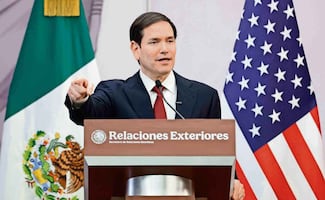Más Información

EU lanza ataque contra objetivos del Estado Islámico en Siria; Trump dice que es "represalia muy seria"

Clinton, Jagger y Michael Jackson aparecen en archivos de Epstein; pesquisa no es sobre el exmandatario, dice vocero

Corte Interamericana responsabiliza a México por feminicidio de Lilia Alejandra García Andrade; su madre ha luchado desde 2001

"Queremos cerrar este capítulo", dice Salinas Pliego al SAT; esperarán a enero a conocer fundamentos legales de adeudo fiscal

Marco Rubio destaca labor de seguridad de México; "están haciendo más que nunca en su historia", afirma

Hallan cuerpos en finca que ya había sido cateada en Silao, Guanajuato; suman 7 personas encontradas en menos de tres semanas
On Monday, Mexico announced it would close the “ Puente Grande ” federal prison . This jail became famous after drug lord Joaquín “El Chapo” Guzmán escaped from it in 2001.
The prison was known for such lax standards that it earned the nickname “Puerta Grande,” or “Big Door.”
The Public Safety Ministry did not give a specific reason for the closure, but said it was part of a modernization effort aimed at ensuring prisoners’ rights and rehabilitation, and also part of a government cost-cutting effort.
The ministry announced all inmates will be transferred to other facilities. The complex, near Guadalajara, also houses at least one other state prison; it was not clear if that would remain open. The exodus began two months ago when authorities relocated 380 inmates to other prisons.
Recommended: The dusk of Mexico's infamous Topo Chico prison
“El Chapo” Guzmán was serving a 20-year sentence when he escaped from the prison using a laundry cart in 2001. According to other versions, he simply paid off prison staff and walked out. While imprisoned at “Puente Grande,” El Chapo had access to a cellphone, and he often organized parties that included alcohol, women, music, and food.
Guzmán would remain on the run for another 13 years, before being re-arrested and escaping another Mexican prison through a tunnel. He was finally re-apprehended, extradited to the United States in 2017, and sentenced to life behind bars in 2019.
But the Puente Grande complex continued making news earlier this year. In May, inmates fought each other with fists and guns at the prison, leaving seven prisoners dead and nine others wounded.
Recommended: Puente Grande prison fight leaves eight dead and eight wounded
Officials did not explain how the inmates got the two guns used in the fight. Of the seven dead, three were shot to death, and four were beaten to death. Six of the nine injured were beaten, and three suffered gunshot wounds.
The killings followed a prison baseball game, but it was not clear if that was related to the dispute. Nor was it clear if allegiance to rival drug gangs could have been involved in the dispute, as is often the case in prison fights in Mexico.
In April, prison authorities canceled visits at the prison after registering three COVID-19 cases.
Famous inmates
“Puente Grande” has jailed criminals like “El Chapo” Guzmán , Los Zetas leaders, La Familia Michoacana leaders, among others.
Vicente Carrillo Fuentes, aka “El Viceroy,” was held at this prison. He took over the Juárez Cartel after his brother, “El Señor de los Cielos,” died in 1997. Authorities arrested Vicente Carrillo in 2014, and he has remained at the prison while the Mexican government approves an extradition request from the U.S., where he faces homicide, drug trafficking, and money laundering charges.
Another infamous resident is Miguel Ángel Treviño Morales, aka “El Z-40.” The criminal is the founder of the bloody Los Zetas Cartel. Mexican authorities arrested him in 2013.
Moreover, the federal prison was also home to José de Jesús Méndez, aka “El Chango,” the founder of La Familia Michoacana. Authorities arrested him in 2011. Before leader La Familia Michoacana, the criminal was a member of the Gulf Cartel, where he was in charge of methamphetamine and cocaine trafficking.
Furthermore, drug lords and criminals have died at the federal prison. In 2019, prison staff found Heleno Madrigal Virrueta, aka “El 20,” dead inside his cell; he allegedly committed suicide. Heleno Madrigal was one of the leaders at the Jalisco New Generation Cartel.
Adrián Gómez Meza died in 2018. He was a financial operator working for the CJNG. Drug producer Gerardo Mendoza Chávez died at the maximum-security prison, he was known for ordering the murder of former Colima Governor Silverio Cavazos in 2010.
However, the infamous prison has also registered the presence of female drug lords and criminals.
Former beauty pageant Laura Elena Zúñiga spent 40 days in the prison over drug trafficking charges. A judge later dropped all charges and ordered her release.
Sandra Ávila Beltrán, better known as “La Reina del Pacífico,” spent some time at the prison before being extradited to the U.S.
Diana Espinosa Aguilar, Caro Quintero’s partner, spent a few years at the facility over her role in a money-laundering network.
gm
Noticias según tus intereses
[Publicidad]
[Publicidad]








